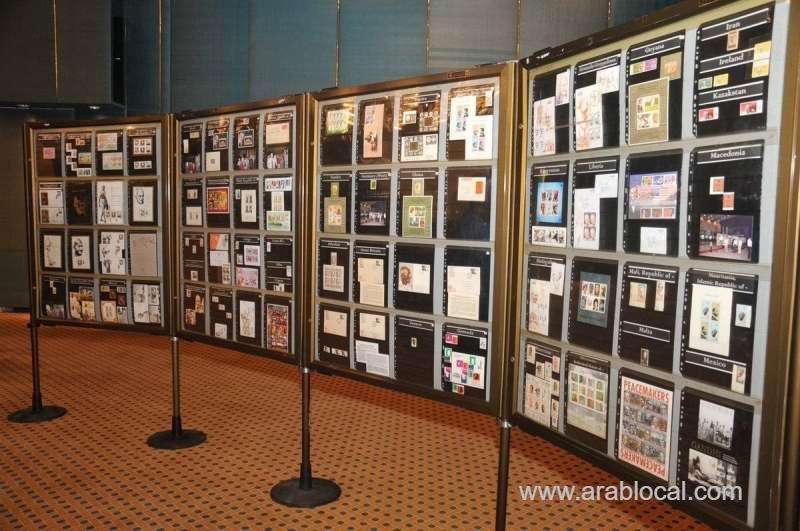Remembering Mohandas Karamchand Gandhi, popularly known as Bapu, was part of @GandhiAt150 celebrations organized by the Embassy of India at the magnificent Cultural Palace in the Diplomatic Quarter here on Oct. 1.
The barrister-turned-anti-colonial nationalist and political ethicist was paid rich and profuse tributes through speeches; documentary films; a bhajan — devotional song — sung by a Saudi singer in the Gujarati language; cultural programs; photo expo, and last but not least the crowd puller concluding item — a stamp exhibition in recognition of Gandhi’s non-violent resistance campaign to lead India’s independence struggle against British rule.
An exhibition of postal stamps on Gandhi by Saudi Gazette’s former senior editor and a philatelist and collector of coins, Mirza Muhammad Nawab (N.A. Mirza), from over 90 countries was the highlight of the celebrations.
Since 1948 Gandhi has been a singular personality in world philatelic history on whom over 90 countries have issued commemorative and definitive stamps; first day covers; limited edition covers; miniatures; sheetlets; brochures; special covers; medallions; souvenirs and other postal stationary. The United States was the first to honor Gandhi on Jan. 26, 1961 with two commemoratives, an FDC, and a brochure.
On the occasion of Gandhi’s 150th birth anniversary most of those countries again issued commemoratives and FDCs. Even Britain, which suffered from Gandhi’s non-violence and non-cooperation, honored him on its postal stationary. Six major British post offices including that of London issued commemoratives, FDCs and brochures on Gandhi.
This is indeed a tribute to Gandhi, popularly known as Mahatma – the great soul. No other leader is remembered that way.
The stamps depict Gandhi as a versatile personality who inspired several world leaders, such as John F. Kennedy, Nelson Mandela, Martin Luther King and many others.
However, there are no stamps on Gandhi from the Pacific region and some of India’s neighbors. The Indian government has time and again also issued commemorative currency notes and coins on Gandhi, including a set of Rs100 and Rs5 coins in silver to commemorate the 75th anniversary of the Salt March, popularly known as the Dandi March. In April 2007, India organized a year-long celebration to commemorate 100 years of satyagraha (agitation) which Gandhi launched in South Africa.
Gandhi is considered the Father of the Nation. His journey from Mohandas to Mahatma was not a flash in the pan but a calculated strategy. After being thrown out of a train’s first class compartment in South Africa by a white man, an angry Barrister Mohandas Karamchand Gandhi did not just fume in anger and protest but allowed his anger to grow further not only to avenge the insult but to end colonialism. And he succeeded. Westerners are known for their planning but Gandhi’s planning puts them to shame even today. Modern written history has no similar example to produce, Mirza said.
He added: “Stamps on Gandhi are a study on Gandhi’s life, his ideals and views on universal brotherhood, communal harmony and social upliftment; his vision of peaceful coexistence, end to colonial exploitation and enduring peace in the world; major events in his life as a tough man of conviction and a believer in non-violence.
Mirza feels that apart from having philatelic importance as a theme, these stamps also highlight Gandhi’s memorable quotes, such as “hate the sin, love the sinner” as seen on stamps from Afghanistan and Gibraltar; “I have discovered that man is superior to the system he propounds” and “... I am slow to see the blemish of fellow beings, being myself full of them and, therefore, being in need of their charity” (Nevis); “My life is indivisible whole, and all my achievements run into one another; and they all have their rise in my insatiable love of mankind” (Ghana); “Do or die” (India); “I believe in truth and therefore, I have no doubt in the future of humanity” (Antigua & Barbados); “I am an irrepressible optimist because I believe in myself” (Guyana).
“These stamps have visual effects too. They depict India’s heritage and rural life as one can see the Taj Mahal, spinning wheel (charkha) in the background on a Madagascar issue; Ashoka’s Lion capital and Gateway of India on a Grenada souvenir sheet; Natraj image and Charminar on Grenada Grenadines issue; beautifully framed portraits of Gandhi on Guyana, Gambia, Ghana, Iran, Mauritius and Syrian issues.
“They also portray Gandhi’s different profiles like Gandhi at the spinning wheel that depict his war against European market (Dominica); Dandi March, salt collection and satyagrah which portray him as a defiant man (India).
Errors on stamps are most sought after by stamp collectors. They are very valuable, said Mirza. “We also see errors and a variety on commemoratives on Gandhi. An Egyptian commemorative in 1969 on Gandhi is the only tri-lingual stamp and the only non-Indian stamp to use Hindi script. It has a spelling error and Gandhi in English is printed as Ghandi. Similarly, on a three set commemorative from Dominica in 1969, an error occurs in the spelling of Gandhi as Ghandi.”
One hundred years after Gandhi’s return to India on ship S.S. Arabia was widely celebrated in 2014. Many stamp exhibitions were held, new special covers with very limited editions were issued. The most spectacular is a limited edition (only 500 sets) of 13-silver-plated medals/capsules set, printed in Germany and issued from Kolkotta between 2014 and 2015. All, with one antique bronze, are unique, eye-catching and give historical details on Gandhi and take the viewer into the realms of history. For example the Chauri Chaura incident in 1922 near Gorakhpur in which 22 policemen were killed which forced Gandhi to stop the non-cooperation movement.
The medals indeed enrich a collection on Gandhi. They are very artistic and worth preserving. The details on both the information sheet with hologram and reverse of the medals are comprehensive and well-researched and much is said in a few words
A write up by Mirza himself at the event read: “Gandhi in stamps and coins is indeed a new dimension which surpasses volumes of all kinds of writings ever written on him. They depict his image as a dynamic and multi-dimensional personality who asserted Hindu ethics; discarded Western ways; practiced asceticism; defied the Raj, launched a civil disobedience movement and his time in jail; campaign for non-violence and passive resistance, and fast unto death in post-Independent India as a political weapon to force the Nehru government to restore peace and order when independent India was in turmoil in the aftermath of the partition.
Gandhi was shot dead on Jan. 30, 1948 while on the way to attend a prayer meeting in Delhi.
“Stamps and coins on Gandhi may inspire researchers to search for the truth when history is being distorted in some quarters. One has yet to answer why the subcontinent was divided when Gandhi described Muhammad Ali Jinnah as the ambassador of Hindu-Muslim unity. It is on record that Gandhi was seen to be extremely happy while meeting Jinnah. These stamps on Gandhi provide an impetus to look at history from a different angle.”
SOURCE : SAUDIGAZETTE



